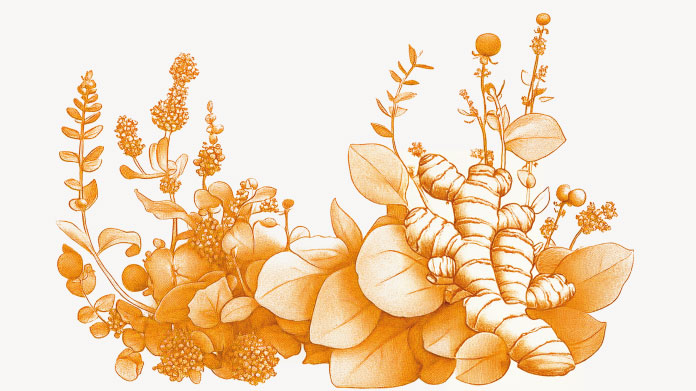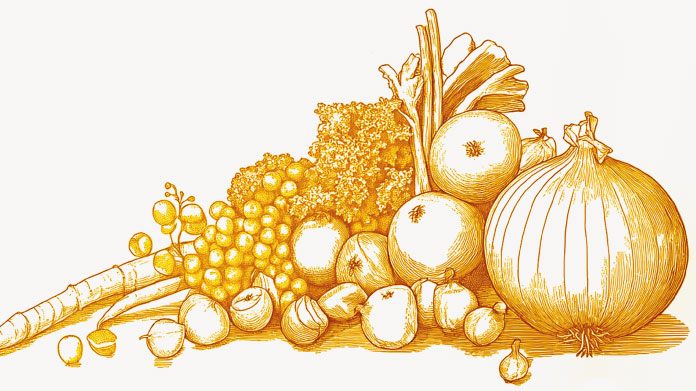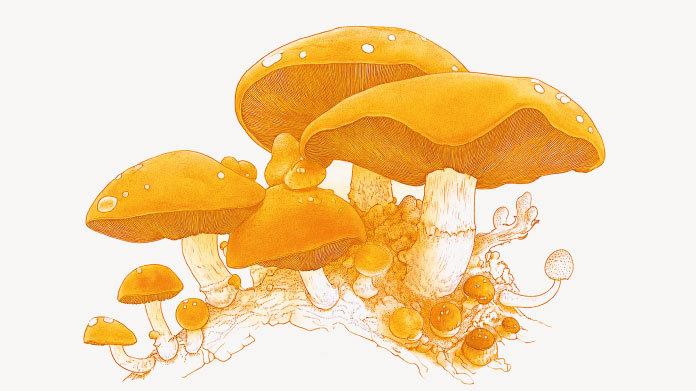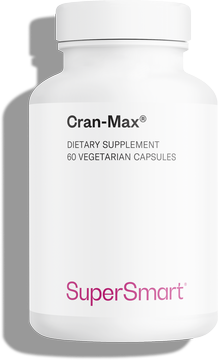What’s the difference between honey and royal jelly?
Though they are both products of the beehive, honey and royal jelly are very different, both in how they are used and in their composition. How do bees produce them? What are their benefits for health?
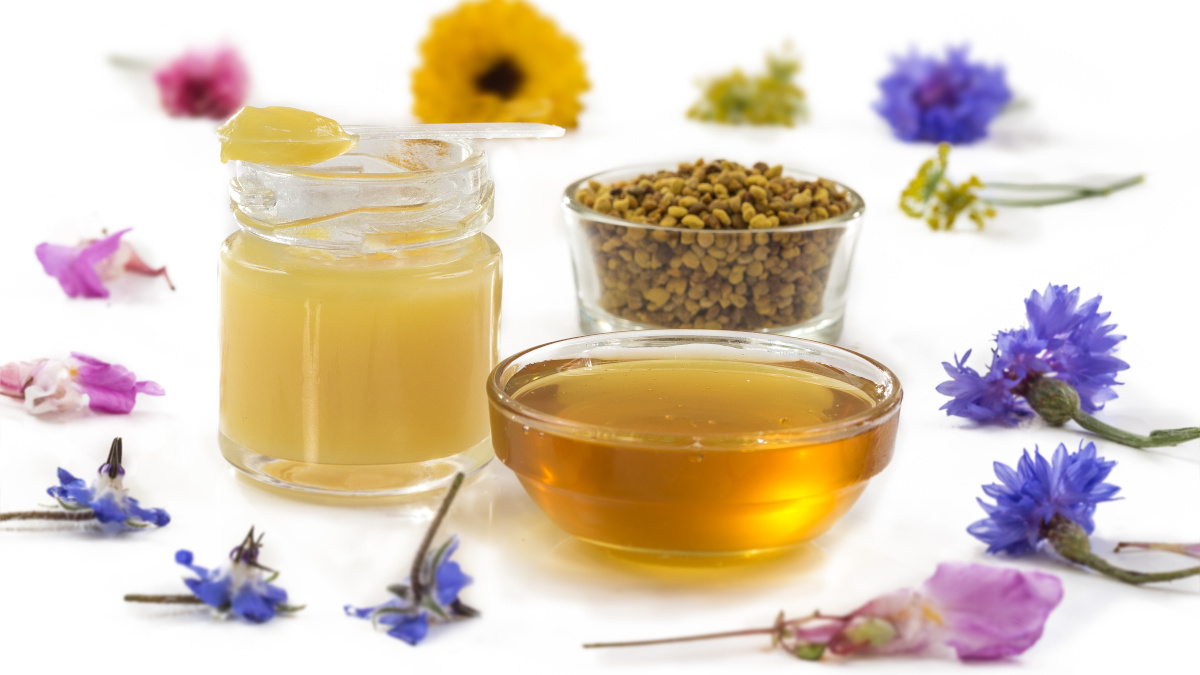
Origin and properties of honey
If humans have always looked after bees, it’s because they’ve always known how to benefit from the various treasures of the beehive.
The first of these is honey, a substance that’s sweet, viscous, and usually amber in color. Produced by by worker bees from the nectar of flowers and honeydew from aphids, honey’s composition is 79.5% carbohydrates and 17% water, plus a number of trace-elements. It is the principal food made by bees.
In ancient times, the Egyptians would offer this nutritious food to their gods as well as using it to make mead or honey wine, sweeten their dishes and treat various ailments (1-2). The Greek philosopher Hippocrates, the father of Western medicine, considered honey a remedy; the physician and botanist Dioscorides described its medical and dietary uses. Many people like to add a spoonful of honey to their tea to soothe the throat.
But it was only in the mid-20th century, with the work of the biologist Belvefer, that another beehive product with amazing properties became very popular: royal jelly (3).
Royal jelly: the extraordinary food of the queen bee
Secreted by the worker bees’ hypopharyngeal glands, royal jelly is a bitter substance, pale yellow and pearly in appearance, produced to feed larvae as they grow, and above all, to nourish the queen bee.
Indeed, the queen of the beehive will be fed exclusively on this aptly-named jelly throughout her life. It is responsible for her considerable growth, longevity and robustness (4).
The composition of royal jelly is typically:
- 50%-65% water, 13%-18% proteins;
- 15% carbohydrates (primarily fructose and glucose);
- essential amino acids (valine, lysine, threonine, leucine, isoleucine, tryptophan, phenylalanine, methionine);
- minerals and trace-elements (calcium, silicon, magnesium, sulfur, potassium, phosphorus, copper, iron, in particular);
- vitamins (B1, B2, B3, B5 and B9) ;
- acetylcholine (a neurotransmitter involved in the function of the central nervous system) ;
- 3%-5% lipids (5).
Most importantly, however, royal jelly uniquely contains three particular molecules:
- 10-hydroxy-2-decenoic acid (10H2DA): a fatty acid which may be responsible for the queen’s longevity - she can live for 5 to 6 years as opposed to the average 60 day lifespan of a worker bee (6);
- royalisin: an amino acid with antimicrobial properties which may account for the queen’s robustness and ability to withstand external aggressors (7);
- royalactin, a protein which may be the key to the queen bee’s strong growth (8).
Longevity, growth and anti-microbial factors: these are the three main attractions of royal jelly for the beehive which have equally been generating scientific interest for more than 70 years.
The wealth of nutrients offered by this food, known also as Bee Milk », is also popular with humans now, especially for overcoming fatigue, stress or during convalescence.
How should royal jelly be consumed?
Rich and complex, royal jelly is meant to be consumed immediately by the queen bee and larvae in the hive, and is not designed to be stored.
It must therefore be protected from sunlight, heat and air in order to preserve all its properties. Fresh royal jelly should therefore always be kept refrigerated in a dark container, from the time it’s collected until it’s consumed.
In fact, one of the most common problems with royal jelly is the appearance of small bubbles in the pot of fresh jelly, indicating that fermentation has begun. And while we might like mead or honey wine, fermented royal jelly is not fit for human consumption.
It is precisely in order to make it easier to store, preserve and consume royal jelly that certain manufacturers have succeeded in freeze-drying it. It can thus be encapsulated and stored in the cupboard, like any other dietary supplement or spice (this is the case for the royal jelly supplementOrganic Royal jelly 4% 10-HDA, which is particularly rich in 10-HDA).
For products providing 100mg of royal jelly per capsule, the dose usually recommended is 2 capsules in the morning with breakfast, and possibly a 3rd capsule with lunch.
Alongside supplementation with royal jelly, we’d also suggest discovering the benefits of propolis, the other nutritional gem from the honeybee, produced by them to protect the hive from infections. Rather than the classic brown propolis, try to opt for either green propolis or red propolis, which are rarer but more potent.
References
- CILLIERS, Louise et RETIEF, François Petier. Bees, honey and health in antiquity. Akroterion, 2008, vol. 53, no 1, p. 7-19.
- FRADELOS, Evangelos. The therapeutic use of honey from Greek antiquity until today. Balkan Military Medical Review, 2013, vol. 16, no 4, p. 456-461.
- VIEL, Claude et DORÉ, Jean-Christophe. Histoire et emplois du miel, de l'hydromel et des produits de la ruche. Revue d'histoire de la pharmacie, 2003, vol. 91, no 337, p. 7-20.
- LECERF, Jean-Michel. Produits de la ruche. Phytothérapie, 2009, vol. 7, no 2, p. 73-74.
- BĂRNUŢIU, Lavinia Ioana, MĂRGHITAŞ, Liviu Al, DEZMIREAN, Daniel S., et al. Chemical composition and antimicrobial activity of Royal Jelly-REVIEW. Scientific Papers Animal Science and Biotechnologies, 2011, vol. 44, no 2, p. 67-72.
- SUGIYAMA, Tsuyoshi, TAKAHASHI, Keita, KUZUMAKI, Akihiro, et al. Inhibitory mechanism of 10-hydroxy-trans-2-decenoic acid (royal jelly acid) against lipopolysaccharide-and interf.-β-induced nitric oxide production. Inflammation, 2013, vol. 36, no 2, p. 372-378.
- FUJIWARA, Suguru, IMAI, Jiro, FUJIWARA, Mineko, et al. A potent antibacterial protein in royal jelly. Purification and determination of the primary structure of royalisin. Journal of biological chemistry, 1990, vol. 265, no 19, p. 11333-11337.
- KAMAKURA, Masaki. Royalactin induces queen differentiation in honeybees. Nature, 2011, vol. 473, no 7348, p. 478-483.
Keywords
1 Days
Great customer service - responsive …
I ordered from them and my item was unavailable for sometime. I was super happy when they reactivated my order and shipped my item which arrived very quickly. Great customer service.
Ruth Rueter
2 Days
Super fast shipping
Super fast shipping
Donald Borling
5 Days
Reputable companysearch and the number of…
The research and the number of selection of products.
NAKHJAVAN Shervin
18 Days
The Anti Aromatase is a great product
The Anti Aromatase is a great product. You just need to have constant inventory. Recently this product has been out of stock.
GEORGE Verne
20 Days
Great help on chat
Great help on chat. Knowledgeable and friendly.
Jason Argos
23 Days
Customer service was fast and friendly.
Customer service helped to stop the transaction process of the subscription. I appreciated that.
Greenie
24 Days
I order here due to the high quality of…
I order here due to the high quality of the products and the quick delivery of items - thank you
Barbara J
25 Days
SuperSmart's Eye Pressure supplements: highly recommended!
I purchase SuperSmart's Eye Pressure supplements regularly for over 5 years, and gotta say they are truly a wonderful product for my Glaucoma. Highly recommended if you have eye pain from your Glaucoma.
D. Martinez
29 Days
Quick service
Quick service
MONELL
30 Days
Speedy service.
Speedy service.
ROSENTHAL Marvin
34 Days
Clear website- Efficient
Clear website. Excellent search engine and fast delivery!
Mohamad Hussein
36 Days
They have great products.
They have great products.
Vickie
36 Days
Great Shipping Time!
You Have A Great Shipping Time! Praise The Lord!
DMHoge
38 Days
Doctor Recommended!
Good pricing, very good availability, doctor recommended (couldn't find what I needed anywhere else), and it took only a week to arrive (which I can't complain about).
Al
39 Days
Great product and fast shipping
Great product and fast shipping
Marie

